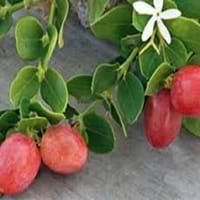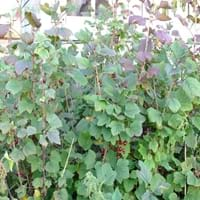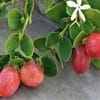Life Span
Perennial
Not Available
Origin
Central Asia, Southern Asia, Western Ghats, India
Hybrid origin
Types
congesta, paucinervia
Not Available
Number of Varieties
Not Available
Habitat
Fertile bottom land, moist forests, Temperate Regions, Tropical Forests
Clay soil areas, Loamy soils, Sandy areas, Well Drained
USDA Hardiness Zone
Not Available
5-9
Sunset Zone
Not Available
A1, A2, A3, 1a, 1b, 2a, 2b, 3a, 3b, 4, 5, 6, 7
Habit
Upright/Erect
Upright/Erect
Flower Color
Pale White, White
Green, Purple
Flower Color Modifier
Bicolor
Bicolor
Fruit Color
Purple, Black
Red, Purple, Burgundy, Black
Leaf Color in Spring
Green
Green
Leaf Color in Summer
Green
Green
Leaf Color in Fall
Green
Green
Leaf Color in Winter
Light Green
Light Green
Plant Season
Spring, Summer, Fall
Summer, Fall
Sunlight
Full Sun, Partial Sun, Partial shade
Full Sun, Partial Sun, Partial shade
Growth Rate
Medium
Medium
Type of Soil
Loam
Clay, Loam, Sand
The pH of Soil
Acidic, Neutral, Alkaline
Acidic, Neutral, Alkaline
Soil Drainage
Well drained
Well drained
Tolerances
Drought
Drought
Where to Plant?
Ground
Ground
How to Plant?
Seedlings, Stem Cutting
Budding, Seedlings, Stem Cutting
Plant Maintenance
Medium
Medium
Watering Requirements
Keep the ground moist but not water-logged
Allow to dry out slightly between watering, Do not water frequently
In Summer
Lots of watering
Lots of watering
In Spring
Moderate
Moderate
In Winter
Average Water
Average Water
Soil pH
Acidic, Neutral, Alkaline
Acidic, Neutral, Alkaline
Soil Type
Loam
Clay, Loam, Sand
Soil Drainage Capacity
Well drained
Well drained
Sun Exposure
Full Sun, Partial Sun, Partial shade
Full Sun, Partial Sun, Partial shade
Pruning
Prune if you want to improve plant shape, Remove dead leaves
Do not prune during shooting season, Remove damaged leaves, Remove dead branches, Remove dead leaves, Thinning
Fertilizers
Compost, fertilize in growing season
Apply N-P-K, since leafy plants, use higher nitrogen content fertilizer
Pests and Diseases
Aphids, Earwigs, Insects, Mildew, Red blotch, Rust, sawflies
Birds, Leaf spot, Red blotch
Plant Tolerance
Dry soil, Heat And Humidity
Drought
Flowers
Insignificant
Insignificant
Flower Petal Number
Single
Single
Foliage Texture
Medium
Medium
Foliage Sheen
Matte
Glossy
Attracts
Birds, Butterflies, Fruit Bats
Birds
Allergy
Eczema, Mouth itching, Throat itching
Not Available
Aesthetic Uses
Not Available
Cottage Garden
Beauty Benefits
good for lips, Remove blemishes
Not Available
Environmental Uses
Air purification, Food for animals, Food for birds, soil stabilisation
Air purification
Medicinal Uses
Anemia, Diuretic, Potassium, Rich in Iron, Vitamin C
Not Available
Part of Plant Used
Fruits, Leaves
Fruits
Other Uses
Added to salads, Cosmetics, Culinary use, Used as a nutritious food item, Used As Food, Used for its medicinal properties
Used As Food
Used As Indoor Plant
No
No
Used As Outdoor Plant
Yes
Yes
Garden Design
Edible, Fruit / Fruit Tree, Hedges
Edible, Fruit / Fruit Tree, Hedges, Mixed Border
Botanical Name
Carissa carandas
RIBES x culverwellii
Common Name
Black Currant
Jostaberry
In Hindi
करोंदा, कालि मैना
Jostaberry
In German
Carandas
Jostaberry
In French
karondas
casseille
In Spanish
karondas
Jostaberry
In Greek
karondas
Jostaberry
In Portuguese
karondas
Jostaberry
In Polish
karondas
Jostaberry
Phylum
Magnoliophyta
Magnoliophyta
Class
Magnoliopsida
Equisetopsida
Order
Gentianales
Saxifragales
Family
Apocynaceae
Grossulariaceae
Clade
Angiosperms, Asterids, Eudicots
Angiosperms, Core eudicots, Eudicots
Tribe
Not Available
Not Available
Subfamily
Not Available
Not Available
Number of Species
Not Available
Season and Care of Karonda and Jostaberry
Season and care of Karonda and Jostaberry is important to know. While considering everything about Karonda and Jostaberry Care, growing season is an essential factor. Karonda season is Spring, Summer and Fall and Jostaberry season is Spring, Summer and Fall. The type of soil for Karonda is Loam and for Jostaberry is Clay, Loam, Sand while the PH of soil for Karonda is Acidic, Neutral, Alkaline and for Jostaberry is Acidic, Neutral, Alkaline.
Karonda and Jostaberry Physical Information
Karonda and Jostaberry physical information is very important for comparison. Karonda height is 120.00 cm and width 120.00 cm whereas Jostaberry height is 120.00 cm and width 120.00 cm. The color specification of Karonda and Jostaberry are as follows:
Karonda flower color: Pale White and White
Karonda leaf color: Green
Jostaberry flower color: Green and Purple
- Jostaberry leaf color: Green
Care of Karonda and Jostaberry
Care of Karonda and Jostaberry include pruning, fertilizers, watering etc. Karonda pruning is done Prune if you want to improve plant shape and Remove dead leaves and Jostaberry pruning is done Do not prune during shooting season, Remove damaged leaves, Remove dead branches, Remove dead leaves and Thinning. In summer Karonda needs Lots of watering and in winter, it needs Average Water. Whereas, in summer Jostaberry needs Lots of watering and in winter, it needs Average Water.





